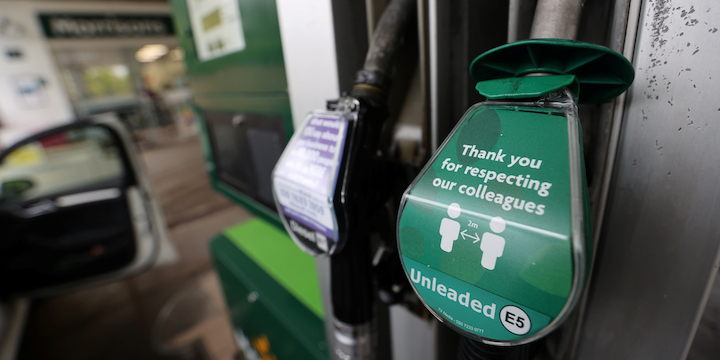
A notice telling people to stay 2 meters apart is seen at a petrol station, following the outbreak of the coronavirus disease (COVID-19), Stone, Britain, April 28, 2020. Photo: REUTERS/Carl Recine
Severe coronavirus restrictions around the world to contain surging infection rates weighed on fuel sales, weakening the prospect of energy demand recovery in the first half of 2021.
Most of Europe is now under the strictest restrictions, according to the Oxford stringency index, which assesses indicators such as travel bans and the closure of schools and workplaces.
The United Kingdom’s new national lockdown is expected to last until mid-February at least. The German government, meanwhile, has extended its own strict lockdown until the end of January and Italy has extended to Jan. 15 a ban on movement between 20 regions.
As a result, traffic in London, Rome and Berlin fell sharply in late December and early January, data provided to Reuters by location technology company TomTom shows.
Related coverage

January 9, 2021 3:21 pm
Tough restrictions on socializing and businesses continued in California, the most populous US state and one of the largest driving markets in the world.
Driving in the whole state on Friday was down 15% from a baseline volume on Jan. 13 last year, Apple Mobility Trends showed, while use of public transport dropped more than 60%.
Road traffic in San Francisco remained subdued, TomTom data showed, and mobility in New York City has dropped sharply after showing some signs of recovery late last year.
These trends are unlikely to reverse significantly in the coming weeks, BCA Research said, and the pandemic will remain a key challenge for fuel demand in the front end of 2021, albeit to a lesser degree than last spring.
More aggressive lockdowns are already weighing on fuel sales, with government data on Thursday showing average sales per filling station in Britain 21% lower than the previous week, which the report attributed to low sales around Christmas and coronavirus-related restrictions.
Global oil demand was at 94.7 million barrels per day (bpd) in the last quarter of 2020, almost 6% lower than the same period last year, International Energy Agency (IEA) data showed. The agency forecast in December that demand would stay at the same level in the first quarter of 2021.
Amid renewed restrictions, both US and European gasoline stocks have risen in the past week, official and industrial data showed.
In the United States last week, the total volume of petroleum products supplied to the domestic market – a proxy for consumption – was down almost 12% year on year, US Energy Information Administration (EIA) data showed.
Supplied finished motor gasoline was almost 8% down both year on year and from the previous week.
The EIA has estimated that US gasoline consumption fell to 8.09 million bpd in 2020, from 9.31 million bpd the previous year. It has forecast that gasoline demand will rebound slightly to 8.76 million bpd in 2021.
WEAKENED OUTLOOK
Goldman Sachs this week said its updated first-quarter market balance outlook had weakened, owing to renewed lockdowns.
OPEC also said this week that emergence of a new variant of the virus and curbs on social activities put more downside risks on oil markets in the first half of 2021, forcing most members to keep production steady while Saudi Arabia offered a big voluntary cut.
“The Kingdom’s preemptive move suggests to us a desire to defend prices and support the oil market amid demand concerns due to extended mobility restrictions in Europe,” UBS analysts said, predicting a rebound only in the second quarter of 2021 as vaccination programs take effect.
China also introduced more restrictions near Beijing. Shijiazhuang, the capital of China’s Hebei province, has banned all residents from leaving the city as part of COVID-related curbs, a city official said on Thursday.
The new restrictions brought the traffic in Shijiazhuang to a standstill, TomTom data showed.
However, demand remained strong in many countries, with Apple Mobility Trends showing driving in Brazil, Saudi Arabia, India and Australia has surpassed pre-pandemic levels.
The recovery was particularly strong in the United Arab Emirates, the data showed.
In Dubai, driving dropped in March and April but this week was 300% above the baseline, attributed to tourist numbers.
Related posts:
Views: 0
 RSS Feed
RSS Feed

















 January 10th, 2021
January 10th, 2021  Awake Goy
Awake Goy  Posted in
Posted in  Tags:
Tags: 
















